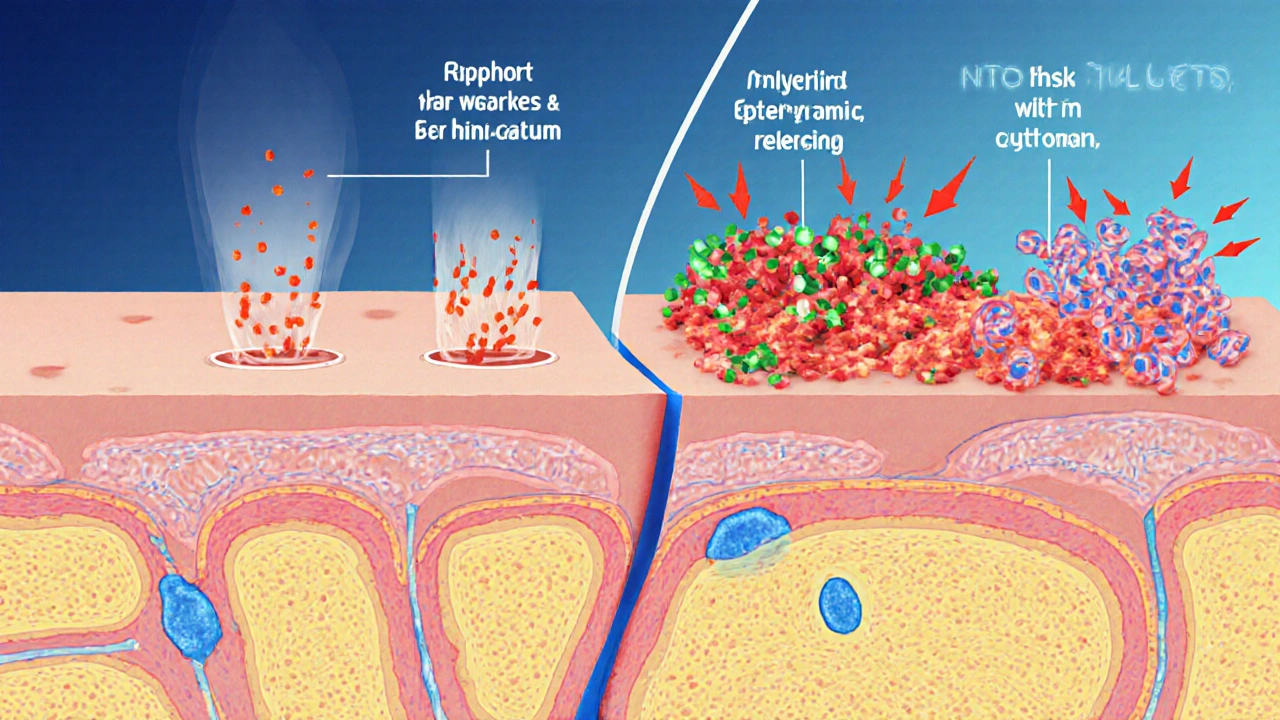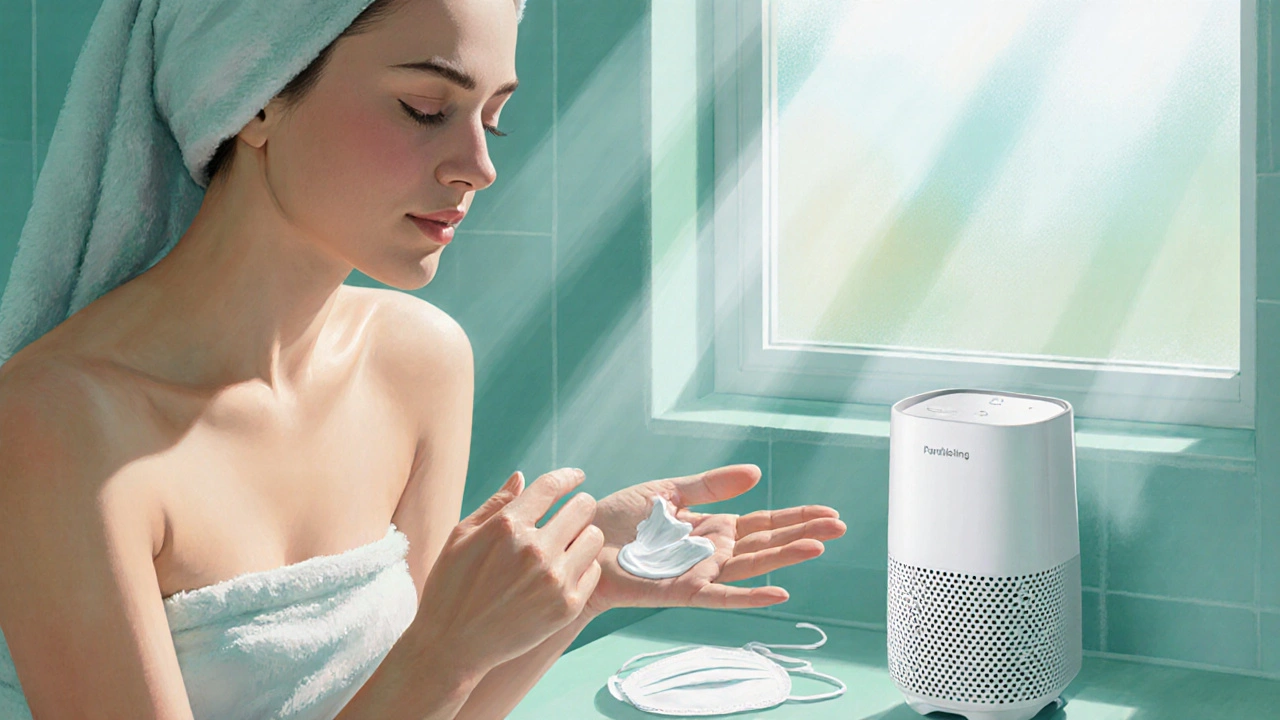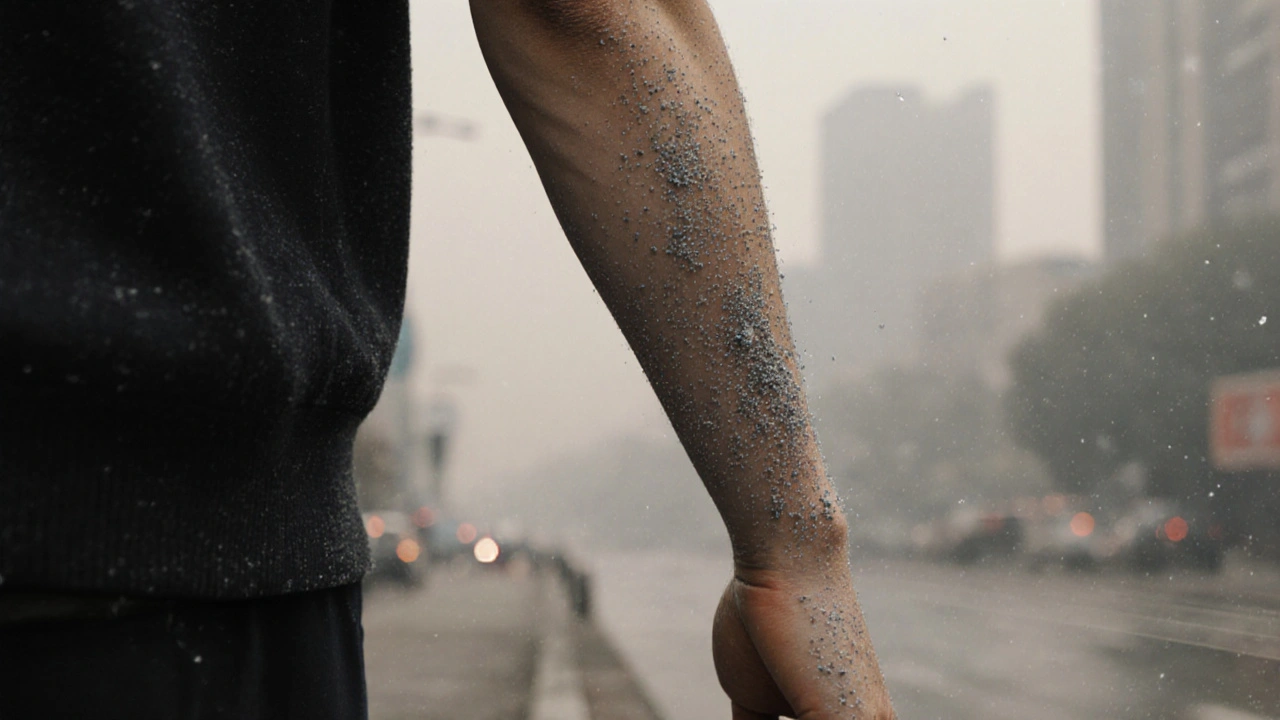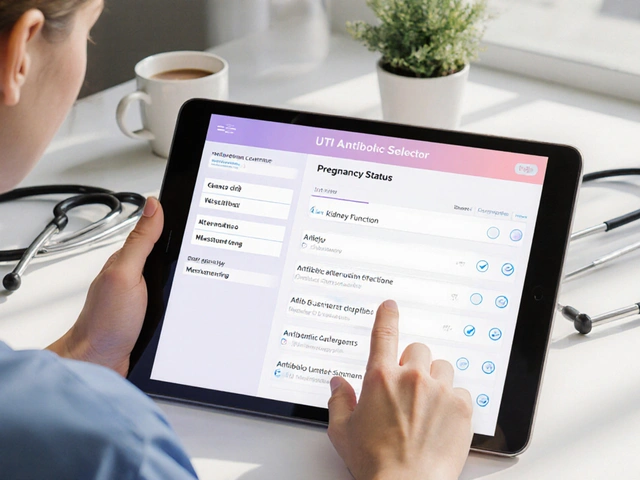Pollution Skin Risk Calculator
This calculator estimates your risk of pollution-related skin infections based on your exposure levels and skin condition. Enter your details to get personalized prevention recommendations.
Personal Risk Assessment
Your Risk Assessment
Ever wondered why you break out more often on smoggy days or why a rash lingers after a swim in a polluted river? The link isn’t a coincidence - pollution skin infections are real, and the science behind them is surprisingly straightforward. This article breaks down how different types of pollution mess with your skin’s defenses, what kinds of infections you might see, and practical steps to keep your skin safe.
Quick Takeaways
- Airborne particles (PM2.5) and heavy metals weaken the skin barrier, making infections easier.
- Waterborne contaminants can directly introduce bacteria and fungi to the skin.
- Chronic exposure amplifies inflammation, leading to conditions like eczema that act as gateways for infections.
- Simple habits - proper cleansing, barrier‑repair moisturizers, and limiting exposure - dramatically cut risk.
- Knowing the specific pollutants in your area lets you tailor protection strategies.
What Is Pollution and Why It Matters for Your Skin
In the broadest sense, Pollution is the introduction of harmful substances into the environment that disrupt natural processes. While we often think of pollution in terms of air quality or climate, it also includes water‑borne chemicals, soil contaminants, and indoor pollutants like volatile organic compounds (VOCs). Each of these can interact with the skin, which is the body’s largest organ and first line of defense against the external world.
How the Skin Defends Itself - The Barrier Concept
The skin’s protective shield consists of three layers: the outermost stratum corneum, a lipid‑rich matrix, and resident microbes that form a healthy microbiome. This barrier does three jobs:
- Keeps water inside.
- Blocks pathogens.
- Neutralizes irritants.
When any of these components are compromised, the skin becomes an open door for bacteria, fungi, and viruses.
Air Pollution: The Invisible Invader
Most people associate smog with breathing problems, but tiny airborne particles also settle on the skin. Air Pollution includes gases like nitrogen dioxide, ozone, and particulate matter (PM). The most dangerous for skin health is Particulate Matter, especially particles smaller than 2.5 micrometers (PM2.5). These particles are small enough to penetrate hair follicles and even the stratum corneum.
Research from the University of Sydney (2024) showed that a 10µg/m³ increase in PM2.5 correlated with a 12% rise in clinician‑diagnosed bacterial skin infections among adults living in high‑traffic neighborhoods.
Mechanisms include:
- Oxidative stress: Reactive oxygen species (ROS) generated by PM2.5 damage skin lipids, weakening the barrier.
- Inflammatory signaling: Pollutants trigger cytokine release (IL‑1α, IL‑6) that makes the skin more prone to inflammation.
- Microbiome disruption: Studies reveal a drop in beneficial Staphylococcus epidermidis after a week of high‑pollution exposure, allowing opportunistic pathogens to flourish.

Water Pollution: Bathing in Trouble
Contaminated water can directly inoculate the skin with microbes. Water Pollution includes bacterial load, heavy metals like lead and mercury, and chemical irritants from industrial runoff. Swimming in polluted lakes or using poorly treated tap water can introduce organisms such as Pseudomonas aeruginosa, which cause “hot‑tub folliculitis,” a painful rash around hair follicles.
Heavy metals bind to skin proteins, altering their structure and impairing wound healing. A 2023 Australian study found that children exposed to elevated lead levels in river water had a 1.8‑fold increase in impetigo cases.
Soil and Indoor Pollution: The Hidden Sources
Dust indoors often contains a mixture of outdoor pollutants, mold spores, and VOCs from cleaning products. Soil contamination, especially in urban gardens, can expose skin to polycyclic aromatic hydrocarbons (PAHs) that have been linked to chronic dermatitis.
While not as immediately obvious as smog, these sources continuously coat the skin and, over months, degrade its protective function.
Types of Skin Infections Linked to Pollution
Pollution doesn’t cause a single disease; it creates an environment where several infections thrive. Below is a quick snapshot:
| Infection | Typical Pathogen | Pollution Trigger | Common Symptoms |
|---|---|---|---|
| Impetigo | Staphylococcus aureus, Streptococcus pyogenes | Airborne PM, waterborne bacteria | Red sores, honey‑colored crusts |
| Hot‑Tub Folliculitis | Pseudomonas aeruginosa | Contaminated water, chlorine breakdown products | Itchy papules around hair follicles |
| Fungal Tinea (ringworm) | Trichophyton spp., Microsporum spp. | Moist, polluted indoor environments | Ring‑shaped, scaly patches |
| Atopic Dermatitis Flare‑Ups | Mixed bacterial overgrowth | Air pollutants, VOCs, heavy metals | Dry, itchy, inflamed patches |
The Science Behind the Damage: A Closer Look at Mechanisms
To understand why pollution leads to infection, consider three intertwined pathways:
1. Barrier Disruption
Heavy metals like cadmium replace calcium in skin lipids, making the stratum corneum more permeable. PM2.5 embeds itself between corneocytes, physically tearing the barrier.
2. Immune Modulation
Persistent low‑grade inflammation caused by pollutants skews the immune response toward Th2 dominance, which is less effective at killing bacteria. This shift is a hallmark of eczema patients who are already prone to infections.
3. Microbiome Imbalance
Healthy skin hosts a diverse bacterial community that competes with pathogens. Pollution reduces diversity (alpha‑diversity drops by ~30% in high‑pollution zones) and favors opportunistic species like Staphylococcus aureus.
Who Is Most at Risk?
While anyone can be affected, certain groups face higher odds:
- Urban dwellers: Daily exposure to traffic emissions and industrial dust.
- Children: Thinner skin and higher outdoor activity increase contact with pollutants.
- People with pre‑existing skin conditions: Eczema, psoriasis, or chronic wounds already have compromised barriers.
- Outdoor workers: Construction, landscaping, and delivery staff spend many hours in polluted environments.

Practical Prevention Strategies
Knowing the culprits is half the battle. Here are evidence‑based steps you can adopt right now:
- Cleanse smartly: Use a gentle, pH‑balanced cleanser after coming indoors. Over‑scrubbing strips natural oils and worsens barrier loss.
- Repair the barrier: Apply a moisturizer containing ceramides, niacinamide, or urea within three minutes of washing. These ingredients replenish lipids and reduce water loss.
- Shield against airborne particles: Wear a breathable, filtered face mask on high‑smog days. Even a simple surgical mask reduces PM2.5 deposition on the skin by up to 40%.
- Limit water exposure: When swimming in lakes or pools with questionable water quality, shower immediately afterward with a mild cleanser.
- Control indoor air: Use HEPA filters, keep humidity between 40‑60%, and choose low‑VOC cleaning products.
- Stay informed: Check local air quality indices (AQI) and water quality reports. Apps like AirVisual provide real‑time PM2.5 levels for Melbourne.
- Nutrition matters: Antioxidant‑rich foods (berries, leafy greens) help combat ROS generated by pollutants.
When to Seek Medical Help
If you notice any of the following, book an appointment:
- Rapidly spreading redness or swelling.
- Painful, crusted lesions that don’t improve after a week of proper hygiene.
- Fever accompanying a skin rash.
- Persistent itching that interferes with sleep.
Early treatment with topical antibiotics or antifungals can prevent deeper infection and scarring.
Future Outlook: How Policy and Technology May Reduce Risks
Governments are tightening emissions standards. Melbourne’s 2025 Clean Air Plan aims to cut PM2.5 levels by 30% over the next decade. On the technology front, wearable skin sensors that monitor barrier integrity are entering clinical trials, promising early alerts before an infection takes hold.
Meanwhile, research into probiotic skin creams-formulations that add beneficial bacteria-shows promising results in restoring microbiome balance after pollutant exposure.
Key Takeaway Checklist
- Identify the main pollution sources in your daily routine.
- Prioritize barrier‑repair moisturizers with ceramides or niacinamide.
- Use protective measures (masks, filters) on high‑pollution days.
- Maintain a clean, low‑VOC indoor environment.
- Watch for early signs of infection and act quickly.
Frequently Asked Questions
Can pollution cause acne?
Yes. Particulate matter and oil‑rich industrial emissions can clog pores and increase inflammation, leading to acne breakouts, especially on the cheeks and forehead.
Is it safe to use antibacterial soap every day?
Frequent use can strip the skin’s natural oils and disrupt the microbiome, making it easier for harmful bacteria to invade. A gentle, fragrance‑free cleanser is usually a better choice.
How does indoor air quality affect skin infections?
Indoor pollutants like VOCs from paints or cleaning agents can irritate the skin, lower its barrier function, and promote fungal growth in damp areas such as bathrooms.
Do heavy metals in water cause skin rashes?
Yes. Metals like lead and mercury bind to skin proteins, causing oxidative damage and delayed wound healing, which can manifest as chronic rashes or impetigo.
What are the best moisturizer ingredients for pollution‑exposed skin?
Look for ceramides (rebuild lipids), niacinamide (anti‑inflammatory), and antioxidants like vitamin C or E (neutralize free radicals). These ingredients directly counteract pollution‑induced damage.






Brooks Gregoria
October 12, 2025 AT 20:19Honestly, the whole premise of linking pollution directly to skin infections feels like a stretch of the imagination. While I appreciate the effort to raise awareness, the article cherry‑picks data without acknowledging the myriad of confounding variables. For instance, personal hygiene habits and genetic predisposition are far more decisive than a single AQI number. Moreover, the suggested remedies read like a marketing brochure for ceramide‑laden moisturizers. The risk calculator is a gimmick that oversimplifies a complex interplay of environmental and physiological factors. You can't reduce a multifactorial condition to a neat score and expect it to hold water across diverse populations. Also, the article fails to address socioeconomic disparities that affect both exposure and access to care. By focusing solely on individual actions, it sidesteps the systemic nature of pollution, which is largely out of personal control. The tone seems more about scaring readers into buying products than offering genuine scientific insight. And let's not forget that the cited studies are from limited geographic regions, making broad generalizations questionable. If you want a real solution, push for policy changes, not just a new lotion. In short, the article is more hype than hard science, and readers deserve a more balanced view.
Sumit(Sirin) Vadaviya
October 14, 2025 AT 00:06Thank you for sharing this comprehensive guide 😊. The explanation of how PM2.5 penetrates the stratum corneum is both clear and scientifically sound. I especially appreciate the practical tip about applying moisturizers within three minutes of showering; timing can be crucial. The inclusion of local AQI resources like AirVisual makes the advice actionable for a global audience. Overall, a well‑structured piece that balances theory with everyday recommendations.
lindsey tran
October 15, 2025 AT 03:52OMG this article is sooo helpful!!!
Krishna Sirdar
October 16, 2025 AT 07:39From a philosophical standpoint, we might view pollution as an external stressor that challenges the skin's innate resilience. Yet, the skin, like any organ, possesses adaptive mechanisms that can be nurtured. Simple acts-like rinsing off after exposure-reinforce those defenses. By aligning daily habits with scientific insights, we transform passive exposure into active stewardship of our bodies.
becca skyy
October 17, 2025 AT 11:26Interesting read! I’ve noticed that people in coastal cities report more skin irritation during red tide events. It makes sense that waterborne toxins can act similarly to airborne particulates. Keeping an eye on local water quality reports can be just as important as checking the smog index.
Theo Roussel
October 18, 2025 AT 15:12The article aptly utilizes epidemiological correlates, yet it could benefit from a deeper exposition of the oxidative stress pathways. For instance, delineating the cascade from NADPH oxidase activation to lipid peroxidation would enrich the mechanistic narrative. Additionally, integrating a discussion on the role of the NLRP3 inflammasome could provide a more granular immunological perspective. Nonetheless, the practical recommendations are grounded in current dermatological standards.
Erick Masese
October 19, 2025 AT 18:59While the article is thorough, it occasionally drifts into overly verbose territory. The core message-that barrier‑repair moisturizers are beneficial-could have been delivered more succinctly. Still, the balanced tone keeps it approachable for a wide readership.
Matthew Charlton
October 20, 2025 AT 22:46Great job breaking down a complex issue into bite‑size actions. Remember, consistency beats intensity-regularly applying a ceramide‑rich moisturizer will do more than occasional heavy‑duty products. Also, encouraging friends and family to check their local AQI can create a community of informed skin‑care enthusiasts. Keep up the supportive vibe!
Pamela may
October 22, 2025 AT 02:32Okay, let me unpack this because there’s a lot to say and I’m not gonna hold back. First off, the article nails the fact that pollutants are like tiny ninjas slipping past our skin’s defenses, but it kinda glosses over how our lifestyle choices can magnify that effect. I mean, we all know how binge‑watching on a dusty couch can add a layer of grime you wouldn’t think about, right? Then there’s the whole "ceramide + mask" combo that sounds like a fancy spa treatment but could be a daily routine for many-yet the cost factor isn’t really addressed, which is a big deal for folks on a budget. Also, the piece mentions indoor VOCs from cleaning products, but doesn’t tell us which brands are actually less toxic-people need that info to make smarter swaps. On the scientific side, the oxidative stress pathway is mentioned, but a deeper dive into the role of glutathione would have been cool. The table of infections is helpful, but I wish it included a column for typical treatment timelines, because let’s face it, we all panic when a rash shows up and want to know how fast we can get rid of it. The recommendation to wear masks is solid, but the article could have noted that not all masks filter PM2.5 equally-N95s are the gold standard, whereas surgical masks are just a little better than nothing. I also appreciate the tip about checking local AQI apps, yet the author missed mentioning that many of those apps now have push notifications that can nudge you to take action before you even step outside. Nutrition advice is there, but maybe a quick list of antioxidant‑rich foods would help readers actually implement it. And hey, the future outlook about wearable skin sensors sounds like sci‑fi, but the timeline for those becoming affordable is still vague-you’ve got to set realistic expectations. Finally, the checklist is great but could use a printable version for quick reference. All in all, the article is solid, but there’s room for more depth, practical cost considerations, and a bit more realism about future tech timelines.
tierra hopkins
October 23, 2025 AT 06:19Solid overview, and I especially like the emphasis on barrier‑repair moisturizers. It’s a practical step that anyone can take right away.
Ryan Walsh
October 24, 2025 AT 10:06Good stuff! Simple tips work best for most people. Just remember to stay consistent with your skin routine.
Karl Norton
October 25, 2025 AT 13:52Another article trying to sell you a product under the guise of science. Same old spiel.
Ashley Leonard
October 26, 2025 AT 17:39Thanks for the detailed breakdown! I’m curious, have you considered adding a section on how seasonal changes affect pollutant levels? That could help readers adjust their skin‑care routines throughout the year.